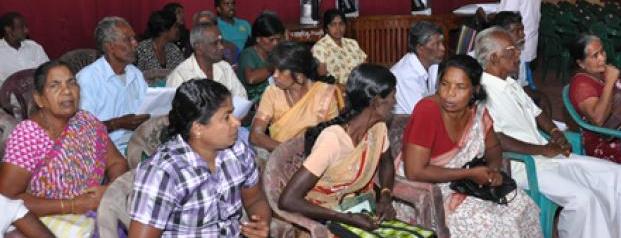[Jaffna: people waiting to give evidence at the Commission sittings]
A “domestic inquiry” of sorts former President Rajapaksa initiated last year has become the focal point of attention. Such an inquiry came about when he extended the mandate of the Commission of Inquiry probing (from August 2013) thousands of persons who have gone missing. On July 17 last year the Commission was additionally tasked to investigate and report on the principal facts and circumstances that led to the “loss of civilian life during the internal armed conflict that ended on May 19, 2009.”
For this purpose Rajapaksa issued a proclamation appointing a team of international advisors. The first four to be named were Sir Desmond de Silva, QC Sir Geoffrey Nice, QC, Rodney Dickson, QC, all three from the UK and David M. Crane from the United States.
For just seven months — from July 7, 2014 to February 7, 2015 — a staggering amount of more than Rs. 135 million has been paid out to them as well as others who were connected with this exercise, according to documents obtained by the Sunday Times. These payments, as well as others revealed today, have been made directly by the Central Bank without approval from the Cabinet of Ministers. These experts, together with others named later, have been in Sri Lanka only on three different occasions, according to Maxwell Paranagama, Chairman of the Commission. He told the Sunday Times that he had met only these four Advisors, and that too in Colombo. “They did not take part in the Commission sittings,” he said.
On their own, they had travelled to Kilinochchi and Mullaitivu, he added. He said the Commission’s term has been extended till August 15 this year. Their next sittings will be in Trincomalee on March 29. The travel to these two districts, according to documents available with the Sunday Times involved an expenditure of Rs. 598,686 for “meals and accommodation.” The travel took place on just two days, December 8 and 9 last year.
Sir Desmond de Silva, QC received GBP 357,336, equivalent to over Rs. 79 million or exactly Rs 79,154,691.13. The other payments for the seven month period are:
Rodney Dixon, QC Sterling Pounds 27,000 or Rs. 5,727,522.84
David M. Crane – US$ 60,000 or Rs 7,814,261.50.
In addition to the above, during the foursome’s visit US$ 22,500 (or Rs. 982,537.50) was spent as “Foreign Currency Expenses.” A further Rs 4,418,214.73 was spent as “Local Currency Expenses.” Other payments:
P.P. Mylvaganam who was not on the Advisory team was paid Sterling Pounds 100,000 or Rs. 20,705,542, Major General J.T. Holmes Sterling Pounds 21,500 or Rs 4,332,910.50, Michael A. Newton US$ 5,000 or Rs 651,730.50. The latter is an expert in accountability, transnational justice and conduct of hostilities issues. The Consortium of Humanitarian Agencies, a local outfit, was paid Rs. 3,735,000. This consortium is headed by NGO wallah Jeevan Thiagarajah. Petty cash to the office has been listed as Rs. 124,285.95.
That is not all. Payments made after the seven month period ended are also colossal. Here are the details of further payments up to February 12 this year:
Sir Desmond de Silva, QC – Sterling Pounds 407,336.00 or Rs. 85,550,666.37. Thus he has been paid a total of exactly Sterling Pounds 764,672 or over Rs. 164 million (or precisely Rs. 164,705,357.50) so far.
Sir Geoffrey Nice, QC and Lady Nice – Sterling Pounds 86,358 or Rs. 18,060,558.98. Thus, he has been paid a total of Sterling Pounds 122,358 or Rs. 25,697,251.08 so far.
David M. Crane – US$ 67,500 or Rs 8,796,799. Thus, he has been paid a total of US$ 127,500 or Rs. 16,611,060.50.
The payments revealed today appear to be only a fraction of what has been found out so far. The fuller magnitude of the expenditure, which would have been enough to build houses for hundreds, instal electricity schemes for villages, provide medical assistance to the North, or to build and equip a few schools, will unfold only when investigations now under way are complete. Even the few disclosures today raise a number of important questions. The role of foreign advisers and eminent persons, in their own way, remains an important question. Since they did not sit at the sessions of the Disappearances Commission, and visited the one time battle areas on their own, were they involved in a process of formulating their own report to counter the one due at the UN Human Rights Council next month?
Is that effort credible and worth more Rs. 400 million that has already been spent on the exercise and more large amounts surfacing as the investigations continue? Was such a project formulated after careful study of its acceptability by the international community, more so since public funds are involved? This was particularly at a time when living costs soared and the public were deprived of relief during the previous UPFA regime. To make matters worse, would the present Government accept any report prepared by the foreign advisors hired at great cost? This is particularly in the light of the new Government’s position that it is in favour of a ‘credible domestic mechanism’ to conduct a probe. Quite clearly, in its efforts to re-build credibility abroad for Sri Lanka, the Government will not want the international community to believe in the previous government’s efforts to pay colossal amounts of money and obtain a report seemingly to its advantage? Even to the most dim-witted, it is clear; it would pose issues of credibility.
from Sunday Times
